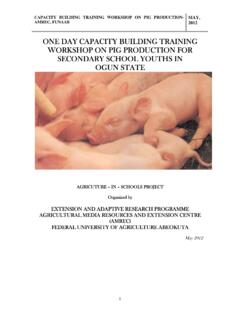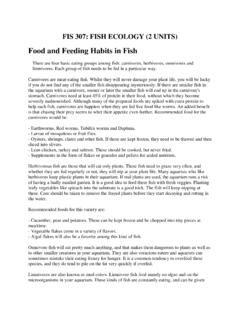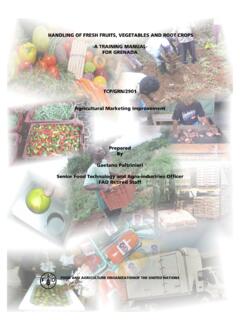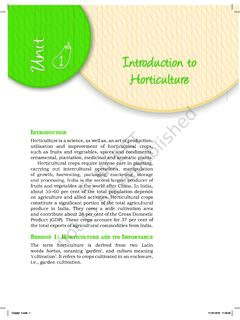Transcription of VEGETABLE CROPS PRODUCTION (HRT 501
1 VEGETABLE CROPS PRODUCTION (HRT 501) Course Lecturers Prof. F. O. Olasantan, Dr E. A. Makinde and Dr. A. W. Salau. Introduction Is an arm of Horticulture in which crop plants are intensively cultivated within a protected area called garden Horticulture is derived from two Latin words: Hortus and Colere. Horticulture is a science that deals with the PRODUCTION and utilization of garden CROPS . Horticulture is divided into four branches. Floriculture: the science of PRODUCTION and utilization of ornamental plants. Olericulture: the science of PRODUCTION and utilization of VEGETABLE CROPS Pomology: the science of PRODUCTION and utilization of fruit CROPS Landscape horticulture: beautification and protection of the environment. Definition of VEGETABLE The term VEGETABLE is used to describe the tender edible shoot, leaves, fruits and root of plants and spices that are consumed whole or in part, raw or cooked as a supplement to starchy foods and meat.
2 CLASSIFICATION OF VEGETABLES 1. According to the part consumed (disposition) 2. According to season or area of PRODUCTION 3. According to their botanical or taxonomy 4. According to their frequency of cultivation 5. According to their maturity time, harvesting pattern and growth habit 1. According to the part consumed Leafy vegetables: the leaves and succulent young shoots are picked for consumption. Examples are amaranthus, celosia, pumpkin, lettuce, cabbage, bitter leaf, water leaf, jews mallow and fluted pumpkin. Fruit vegetables: this comprises of young, immature unripe fruits or mature ripe fruits of plants grown as vegetables. Examples are cucumber, tomato, okra, pumpkin, eggplant, garden egg, water melon, sweet pepper and chilli pepper. Seed vegetables: this group is important for the seed produced. Examples are Egusi melon and Ito melon. Root vegetables: such as sweet potato, irish potato, carrot and radish.
3 Spices: important for their flavor and colour in foods such as chilli pepper, onion, garlic and basil. 2. According to Season/Climatic area/ area of cultivation Cool season vegetables: such as cabbage, garlic, onion, radish, spinach, lettuce, potato and carrot. Warm season vegetables: such as tomato, pepper, cucumber, okra, eggplant, garden egg, melon, pumpkin, sweet potato. 3, Botanical or Taxonomic Classification Vegetables are classified according to family, genera and species. It is the most important and acceptable form of classification. Family Botanical name Common name Amaranthaceae Amaranthus dubius Celosia argentea Amaranth Celosia Cucurbitaceae Cucurbita maxima Cucumis sativus Pumpkin Cucumber Malvaceae Abelmoschus esculentus (L.) Moench Okra Solanaceae Solanum tuberosum Solanum melongena L. Irish potato Eggplant Tiliaceae Corchorus olitorius L. Jews mallow Compositae Vernonia colorata Lactuca sativa Bitter leaf Lettuce Cruciferae Brassica oleraceae Raphanus sativus Cabbage Radish Portulaceae Talinum triangulare Water leaf Basellaceae Basella rubra Indian spinach 4.
4 Frequency of Cultivation Regularly cultivated vegetables Onion, Amaranthus, Celosia, Egusi melon,Okra; Egg plant, Tomato and Pepper Occasionally/Wild vegetables such as: mushroom (Agaricus spp, Celosia triguna Ajefawo) Basella Rubra (White) Indian spinach Basella alba (Red) Crassocephallum biafrae - Bologi, C. crepidoidis - Ebolo 5. According to their maturity time, harvesting pattern and growth habit Vegetables with short growing period and harvested two or three times by topping or young leaf removal: This group consists of leafy vegetables such as Amaranthus spp and Celosia argentea. Vegetables which can be harvested over several weeks or months: This group comprises of vegetables such as Corchorus spp, Solanum spp, Capsicum spp, Tomato, Okra, and Cucurbits. Vegetables with Climbing growth habit: these are vegetables which are trained along a stake and on house walls. Examples are snake gourd, fluted pumpkin, ito melon and basella spp.
5 Vegetables with Creeping stems: such as melon, cucumber and water melon. VEGETABLE Type 1. Indigenous vegetables These are vegetables that are associated with the hot, humid tropical Africa. They are adapted to the hot temperatures and heavy rainfalls of the tropics. In tropical Africa, where starchy root CROPS are the staple food, they are generally consumed as supplements to the starchy staple foods. They provide a cheap source of protein,vitamin and minerals. The indigenous vegetables are usually cultivated under mixed cropping systems as minor CROPS . They are more prominent in compound/backyard farms. They are usually grown with household organic refuse or farm yard manure. They are rarely fertilized with inorganic fertilizers Women are key players in PRODUCTION , processing and marketing of indigenous vegetables Cultivation require low capital/cash requirement and relatively small land area Also, a tangible profit can be realized over time.
6 2. Exotic-type vegetables They originate in areas with cool season climate/temperate region. In Nigeria, they are grown in high altitude areas such as Sahel and tropical uplands of Jos and Adamawa state. They are very popular especially in the urban areas Vegetables in this groups are: Beet, lettuce, cabbage, radish, carrot, irish potato etc. PRODUCTION of exotic vegetables in the mixed system is often impossible because of the following reasons: There is poor demand for exotic vegetables Cultivation of exotic demands special methods which are difficult and expensive Exotic VEGETABLE has poor seed formation and storage under warm season tropical conditions. Exotic vegetables have peculiar taste, texture and special cooking requirements which are not acceptable to most homes in tropical IMPORTANCE OF VEGETABLES IN HUMAN DIET Vegetables supply most of the nutrients that are deficient in other food materials.
7 This includes supply of minerals, especially calcium and iron. Vegetables are acid neutralizers okra, Corchorus spp neutralizes the acid produced from the some fruits. Vegetables prevent constipation and promote digestion as a result of fibres/roughages obtained from okra, cucumber, amaranthus, lettuce and cabbage. Vegetables are rich sources of vitamins A, B, and C which helps to lower susceptibility to infection. : Carrots, sweet corn, amaranthus and celosia provide Vitamin A; Bitter leaf, water leaf, solanum and celosia provide Vitamin B; Tomatoes, carrots, lettuce, cabbage and amaranthus provide Vitamin C. Also, some vegetables are rich sources of carbohydrate potatoes, sweet corn, carrot etc. Green beans and peas are cheap sources of protein. Vernonia (Bitter leaf), Amaranthus and Telfeira provide some amount of protein in human diet. Vegetables are generally needed to have balanced diets and overcome nutritional deficiencies.
8 Vegetables make our staple food more palatable and enhance their intake. The practice of cultivating vegetables and spices for food, composite seasoning and medicine is referred to as Olericulture. Olericulture is one of the four general and sub-categories of horticulture. Others are Pomology, Floriculture, and Landscape gardening/ Principles and Practice of VEGETABLE productions There are some principles required in the PRODUCTION of VEGETABLE CROPS which are very important and well known to the grower. These principles are: 1. PRODUCTION of vegetables does not involve a long- time investment as does in the orchard of citrus, mango, or cashew. 2. VEGETABLE growers/farmers are not bound to produce the same crop each year like his counterparts, who grow fruit CROPS . 3. VEGETABLE growing lacks the stability which is methodically developed over a period of years like an orchard thus, getting into VEGETABLE PRODUCTION is a fast process and getting out may even be faster.
9 4. Vegetables can be grown by people with limited experience. Only skillful farmers sustain their VEGETABLE PRODUCTION 5. The land for PRODUCTION of VEGETABLE CROPS is flexible and adjustable. It is much easier for VEGETABLE growers/farmers to change PRODUCTION from one crop to another than for fruit crop grower. 6. Cooperative efforts and organizations are somewhat more difficult with VEGETABLE crop producers than fruit growers. VEGETABLE /grower/farmers have no long period for making plans. VEGETABLE PRODUCTION is seasonal. 7. VEGETABLE PRODUCTION requires more intensive PRODUCTION management per unit area and time. Practices of VEGETABLE CROPS PRODUCTION The several practices of productions have developed as a result of rapid urbanization and socio-economic and political situations. The practices are highlighted below: 1. Home Gardening: the principal source of fresh local VEGETABLE supplies for most homes.
10 It supplies an important part of the family needs and additional tax-free income. 2. Market Gardening: It takes care of both family needs and market supplies; PRODUCTION goes beyond family taste or needs. It depends on urban market demands. 3. Commercial PRODUCTION : The principal source of vegetables for big market. It is more extensive and specialized than market gardening. The area of PRODUCTION is determined by climatic and edaphic factors. 4. PRODUCTION for Processing: The principal source of fresh VEGETABLE for processing industries .The scale of operation is similar to that of commercial PRODUCTION . 5. VEGETABLE Forcing: The practices of producing vegetables out of their normal PRODUCTION season. It may be accomplished by modifying the growing environment such as heat provision or protection from cold, etc. 6. Controlled Environment Agriculture: The practice of modifying the natural environment for optimum plant growth and PRODUCTION of growth factors such as light, air, temperature, water, relative humidity, etc.











